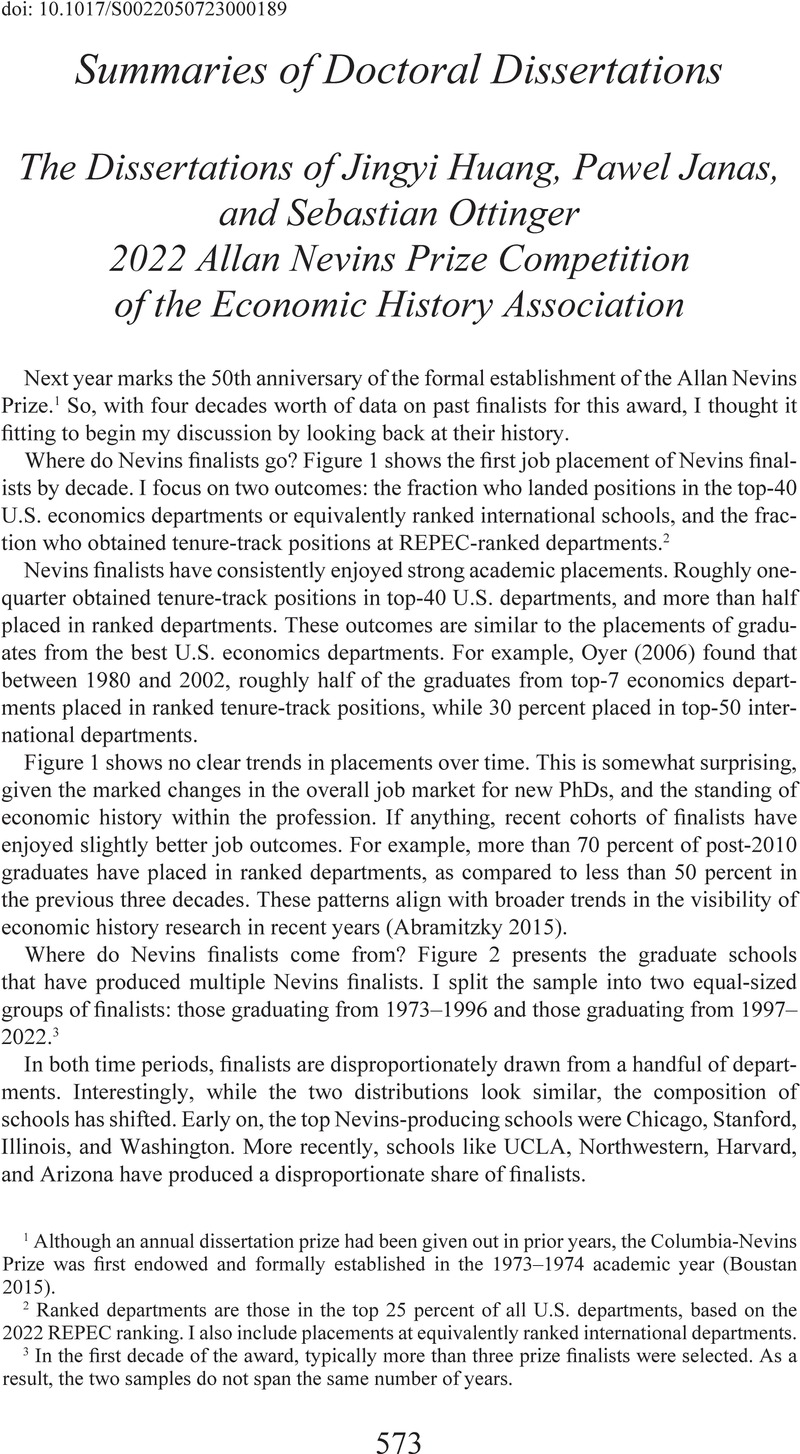No CrossRef data available.
Article contents
Summaries of Doctoral Dissertations
Published online by Cambridge University Press: 18 May 2023
Abstract

- Type
- Dissertation Summary
- Information
- Copyright
- © The Author(s), 2023. Published by Cambridge University Press on behalf of the Economic History Association
References
1 Although an annual dissertation prize had been given out in prior years, the Columbia-Nevins Prize was first endowed and formally established in the 1973–1974 academic year (Boustan 2015).
2 Ranked departments are those in the top 25 percent of all U.S. departments, based on the 2022 REPEC ranking. I also include placements at equivalently ranked international departments.
3 In the first decade of the award, typically more than three prize finalists were selected. As a result, the two samples do not span the same number of years.
2 The term “fiscal-military state” coined by Brewer (1990) has been widely recognized. Meanwhile, see Tilly (1975, 1990) for the eminent thesis that “war made the state.” Finer (1997) and Epstein (2000) focus on specific political or socioeconomic aspects. Other works centering on wars offer more nuanced mechanisms of fiscal-military transitions by combining certain structural factors and timings of transitions (Poggi 1978; Downing 1992; Ertman 1997).
3 See North and Weingast (1989) for the “constitutions and commitment” paradigm in Britain. For more theories, see Levi (1989), Besley and Persson (2008, 2009, 2010, 2011), and Genniaoli and Voth (2015). For empirical evidence, see Rosenthal (1998), Kiser and Linton (2002), Dincecco (2009), Karaman and Pamuk (2013), and Dincecco and Katz (2016). For recent surveys, see Hoffman (2015) and Johnson and Koyama (2017).
5 For instance, see Dincecco, Fenske, and Onorato (2019) for Sub-Saharan African evidence.
6 Besley and Persson (2010) indicate a negative effect of internal war; for corresponding empirical evidence, see Centeno (2002), Cárdenas, Eslava, and Ramirez (2014), and Ch et al. (2018). Contrastingly, Slater (2010) and Rodríguez-Franco (2016) show how internal conflicts foster rather than impede fiscal development.
10 For example, in imperial China, the prima facie fiscal centralization was maintained in the long Ming-Qing history, but the state apparatus as a whole undertook tremendous communication costs (Sng 2014). This thesis argues that due to this severe principal-agent problem, the fiscal regime suffered a long-term malaise.
14 Although long-distance trade was disturbed by warfare, resilient short-distance trade still provided local governments with sufficient tax sources.
16 The lijin surveys come from Luo (1936) and Chen (2015).
17 This chapter aggregates domestic customs revenue data (Ni 2017), maritime customs revenue data (Tang 1992), and lijin data (collected in this thesis) to examine the overall performance and structural change of late Qing indirect taxation. Furthermore, it employs data on population (Cao 2001), wages (IISH 2019), and GDP (Broadberry, Guan, and Li 2018; Ma and de Jong 2019) to measure the temporal changes of Qing indirect taxation capacity.
18 See Van de Ven (2014) for a survey of the maritime customs system.
19 The compilations employed are Xu (1962), PBCCO (1991), and Xu (1996).
20 In comparison, the Qing central court resorted to foreign loans in a very late phase for massive war reparations in 1895–98 and 1901, which brought disastrous and prolonged consequences to the entire fiscal system by crowding out other investment opportunities and intensifying the central-local conflicts.
22 The Qing central court did attempt to intervene in certain local affairs, such as lijin taxation, modern army building, and railway construction, but due to a lack of information, incentive, and expertise, it was incapable of launching any developmental programs. Its clumsy efforts further intensified the central-local conflicts and eventually brought an end to the empire in 1911.
23 One kuping silver tael, as a central standard, equals 37.27 grams of silver.
24 I exclude the massive war reparation loans.
25 Throughout the entire republican period (1912–49), the role of land taxation became increasingly marginalized; instead, customs taxation, salt sales, lijin (the later tongshui), and borrowing became the mainstay of government income.




